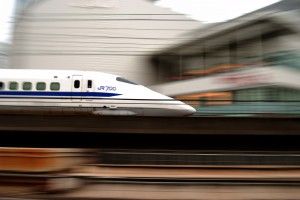Bullet Train Costs Exploding
By ANTHONY PIGNATARO
Trying to pin down an actual, quantifiable, explainable cost estimate for the 800-mile-long proposed high-speed rail system is one of the great games of covering the project. Going back even just two years, a researcher will find all manner of numbers, sometimes within the same government document. The only thing predictable about the differing figures is the extreme likelihood that each new projected cost is greater than the previous.
This was true a decade ago, when California bullet trains were little more than flashy drawings in transportation consultants’ offices, and it’s true now, as the California High-Speed Rail Authority begins planning where, precisely, it will start laying track. Which, as it turns out, involves project cost figures that conflict with other rail authority projections.
On Dec. 2, the rail board voted 7 to 0 to start construction next year on a 65-mile corridor between Madera and Corcoran. How exactly the track will wind along that corridor remains to be seen, but the authority staff felt confident enough about its ultimate design that they put a fairly strong cost projection on it. “Estimates place the cost of the proposed section at $4.15 billion,” stated a Nov. 24 authority press release.
That’s amazing – not the actual cost figure, which is probably still a bit low, but the fact that the rail authority publicized any number at all. Especially one that is so different from the previous figure for that bullet train segment, which in turn calls other, vastly more important, cost projections into question.
On Oct. 1, 2009, the high-speed rail authority filled out this grant application for federal High-Speed Intercity Passenger Rail Program funds. Page 4 dealt specifically with the Fresno-Bakersfield section. At the “Total Cost of the Corridor Program” prompt, rail authority officials wrote “$1,639,000,000.00” (Note: special thanks to Californians Advocating Responsible Rail Design for locating this form, and for first noticing a discrepancy in cost figures).
Not only is the $4.15 billion figure more than twice the cost given the feds last year, it’s for a segment significantly shorter. Keep in mind that the entire Fresno-Bakersfield segment runs between 98 and 109 miles, depending on the final alignment chosen, while the $4.15 billion starter segment approved by the rail board earlier this month is just 65 miles long (on Dec. 20 the rail authority voted6 to 0 to approve spending $1.2 billion in newly acquired federal stimulus dollars and matching local funds on expanding this initial segment to “as many as 120 miles”).
Even more distressing is the fact that the most recent cost figure given for the entire bullet train system – “about $45 billion,” according to this rail authority Frequently Asked Questions webpage – is apparently based, at least on part, on segment numbers like Fresno-Bakersfield costing just $1.64 billion.
Extrapolating from the huge increase in the cost of the Fresno-Bakersfield that all of the rail systems segments are at least twice their current published costs, then the total bullet train cost tops out at roughly $90 billion – far and away the single most expensive construction project in California history and close to the $82.3 billion figure projected by the Reason Foundation in its September 2008 study of California’s bullet train plan.
As Elizabeth Alexis, an economist with CARRD, dryly noted during a recent e-mail on this subject, “The Authority is yet to make any adjustments to its headline project cost figure.”
Rich Tolmach, an analyst active with the California Rail Foundation, was a bit more forceful when he addressed the rail board on Dec. 20. “You’re going on cost estimates that are not trustworthy at this point,” he said.
“The cost estimate for the project is in our 2009 Business Plan,” high-speed rail authority press secretary Rachel Wall e-mailed when asked if the agency was thinking of modifying its most recent cost figure. “According to our report, the cost of the LA/Anaheim-San Francisco system is estimated at $42.6 billion. The cost estimates for the initial construction in the Central Valley thus far are within our overall cost estimate.”
What’s more, Wall insisted that just because the authority told the Fed they could build the entire Fresno-Bakersfield segment for less than $2 billion, it doesn’t mean that the new 65-mile construction costs in any way change that.
“The way in which the state was segmented for the purpose of the environmental review should not be confused with the way in which construction will be sequenced and planned,” she e-mailed. “The Authority will build in the Central Valley and continue building either north or south, initially within the Merced to Bakersfield sections that are environmentally cleared and then continuing toward the Bay Area and Los Angeles. The Authority’s cost estimates for the initial Central Valley construction remain within the overall projected infrastructure budget.”
Wall here is answering a question I never asked. Environmental reviews aside, last year the authority told the feds that it could build the Fresno-Bakersfield segment for less than $2 billion. Of course, the authority through the years has put out many different, often confusing cost numbers.
In 1999, the whole entire bullet train network – including a spur that stretched from San Jose to Oakland which doesn’t even appear to be part of the project anymore – would cost $30 billion. By 2005, the cost had risen to $40.5 billion. Three years later, the San Jose-Oakland segment was gone, but the cost was up to $45 billion.
To be clear, that seems to be a total system cost, including segments stretching from Anaheim to San Diego as well as from Merced to Sacramento. When you just look at the Anaheim to San Francisco run – which the high-speed rail authority trumpets in its publicity materials – the most recent cost is $35.7 billion.
Of course, that figure comes from the authority’s December 2009 Business Plan, which Wall referred to and includes all sorts of cost figures that don’t really add up. For instance, the $35.7 billion figure appears on page 84 of the business plan. “This reflects inflation costs between 2008 and 2009, as well as section cost updates,” states the plan.
Yet the $35.7 billion number doesn’t appear on page 85 of the same report, even though that page shows a number of tables “used in preparing these cost estimates.” Instead, a table titled “Capital Costs By Segment” itemizes the total project cost at $42.594 billion. Then, right below it, is a table labeled “Capital Costs By Item,” which pegs the total cost at $39.284 billion.
“It is typical for costs to rise further as more detailed planning and engineering proceeds,” Reason Foundation researchers Wendell Cox and Joseph Vranich stated in this 2008 report on California’s high-speed rail project. Later in the report, Cox and Vranich quoted from European research showing that costs typically escalate 45 percent in these projects. “The world infrastructure research concluded that ‘Megaproject development is currently a field where little can be trusted, not even – some would say especially not – numbers produced by analysts.’”
Related Articles
Boeing plant closure cuts 2,000 jobs
Boeing, citing shrinking military budgets, announced last week plans to shutter a massive Southern California jet assembly plant and lay
Why a split-roll property tax is DOA
June 11, 2012 By Wayne Lusvardi A proposed ballot proposition circulating for signatures in California for what is called a
Audit: Secretary of State wastes $22 million on voting machines
When Debra Bowen was a candidate for California secretary of state in 2006, two of her top three priorities, according





